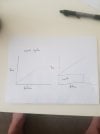Hello Zbanko,Hi Marco, if you are referring to the videos, it’s not my guni wish it was...
It is an invert roller designed by Basil Daniel, one of the strongest (maybe the actual strongest?!) spearguns out there. I have referred to it just to give an example how you can bulk up the rubbers in an invert roller setup without worrying about recoil and losing much precision.
My invert roller will be modest compared to b. daniels. I have a trigger which could take 375 kg of load, so i guess it will be ok with 6x20mm rubber strings. Btw. @Leander @Eray_spearo @snask do you habe any table or info on very roughly how much load caused by different rubber diameters stretched 300-400% ?
Was not able to log in for a while. It is quite nice to see that great discussions are still ongoing. Leander forwarded me a website with calculations on different setups. Assuming that they are correct, it is a nice tool to check not only the output energy but also to compare other parameters.
The video you shared is stunning. However, the rubber combination is much higher than I expected. My gun has 4 x 14mm, I do consider 3 x 16mm. (on both sides). The visibility is up to 10m usually. So a range of 6m with high accuracy is more than enough for me. I have limited equipments so my idea is to find the best of that. Therefore, I would go for 150cm x 7mm Pathos spear.
Here, I would like also to refer to your former post regarding the calculation. It has been quite enlighthening for me. I try to make a comparison between regular guns and invert rollers with more or less same rubber combination. According to my understanding, the energy you can get from invert roller with same rubber combination (thickness and stretch) is 3/4 of the regular one due to the distance between wishbone and notch.
Let me give an example to make it clear:
1. A regular gun with 2 x 14mm rubber, stretch of 350%
2. An invert roller with 2 x 14mm rubber (on each side), stretch of 350%
Lets assume that the force1 in the rubber bands is F. Force in the second variation will be F/2 due to the movable pulley.
Energy = Force x Distance. The distance1 between wishbone and notch is 2x/3 whereas it is x for the second gun. Eventually, the energy in the regular gun will be 2Fx/3 whereas it is Fx/2 for the invert roller.
Energy1 = 4Fx/6
Energy2 = 3Fx/6
If the assumption is correct we can exceed the power of a regular gun by adding the third band to the roller. This is much easier for me to digest
My next statement goes to momentum, a function of mass and speed. The faster the spear goes out, the higher counter momentum will be. However, due to the bands moving to the opposite direction, the recoil of the gun is likely to be less. In the end total momentum needs to be zero which is a compromise between components moving forward and backward.
Of course, friction is also an important parameter but neglected in my statement, assuming that this is quite similar in both cases.
What do you think?
BR
Eray




